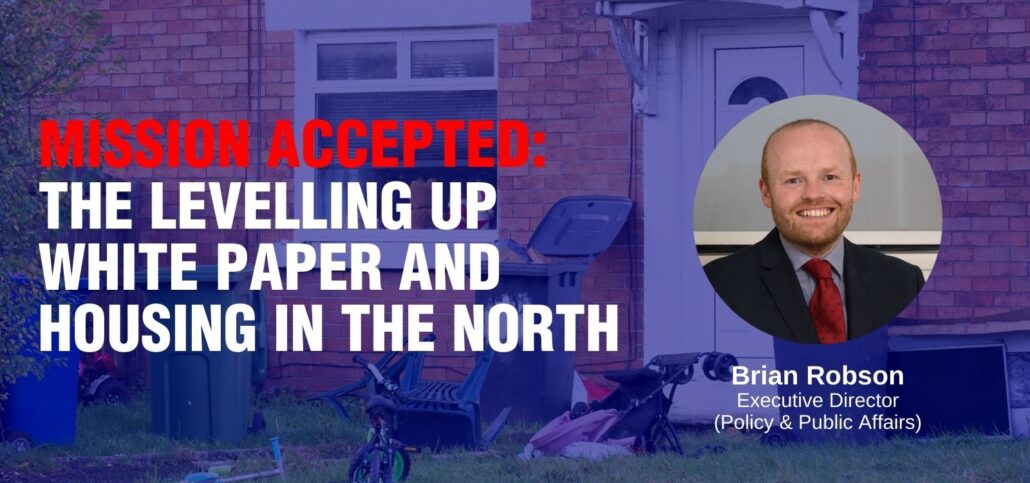Mission accepted: the Levelling Up White Paper and housing in the North
It’s five years since the 2017 Housing White Paper, Fixing our Broken Housing Market, which set out a package of reforms firmly focused on increasing the supply of new homes. Five years on, the Levelling Up White Paper, with its declaration that ‘Nowhere is the need for making opportunity more equal more urgent than in housing’ sets out a very different prescription on housing – it’s a sign that focus is shifting in Westminster, says NHC Executive Director (Policy and Public Affairs) Brian Robson.
Housing strategies don’t come along quite as often as new housing ministers, but they do emerge with a fair degree of regularity. 2007’s Homes for the Future: more affordable, more sustainable was followed by 2011’s Laying the Foundations; and then by 2017’s Fixing our Broken Housing Market. On that basis, we’re due a housing policy shake-up around now – and the Levelling Up White Paper appears to have delivered it.
Fixing our Broken Housing Market placed heavy emphasis on boosting the supply of new homes in the right places. Existing homes were covered in three short paragraphs within a 106-page document. By contrast, the Levelling Up White Paper makes housing quality a priority, with Michael Gove’s foreword calling for a ‘transformation in the quality of housing’.
The White Paper sets out a mission on housing that is broader than just new supply: ‘By 2030, renters will have a secure path to ownership with the number of first-time buyers increasing in all areas; and the government’s ambition is for the number of non-decent rented homes to have fallen by 50%, with the biggest improvements in the lowest performing areas.’
This focus on quality fits with what the Consortium is hearing from our contacts in Westminster and Whitehall: there’s a real shift in thinking on housing, with the Secretary of State taking a keen interest in the quality of existing accommodation. Some have said as much on-the-record: the Director of the Levelling Up Task Force (and former Homes England Deputy CEO) Tom Walker told the Convention of the North earlier this month that the Levelling Up White Paper represents a “very bold change in emphasis on housing policy” with “an emphasis on quality that hasn’t been there for several years… it’s a very significant change.”
So, what does this mean for housing in the North?
The mission on decency has significant implications for our region. If Government wants to see the biggest improvements in the lowest performing areas, we’re going to see particular focus on housing quality in the North West and Yorkshire. Across tenures, Northern Housing Monitor analysis shows non-decency running above the national average in both regions; with Yorkshire recording a rate of failure on the minimum standard criterion that is 50% above the England average. Non-decent homes tend to be older: 46% of the North’s non-decent homes were built pre-1919 and a further 22% between 1919 and 1944. These homes are particularly likely to be found in the North’s villages and isolated rural areas, and in the most deprived decile of neighbourhoods.
It should be noted that the mission excludes a large proportion of the North’s non-decent homes : those that are owner-occupied. 56% of vulnerable residents living in a non-decent home in the North are doing so in a home they own. This is a hard truth that Government will need to confront before long.
In terms of next steps, Government has made clear that further detail will be set out upon conclusion of the Decent Homes Review. We’re also expecting a Private Renting White Paper later this year. The first phase of the Decent Homes Standard Review – looking at the existing standard – has now concluded. The DLUHC Sounding Board, which the NHC is part of, is awaiting ministerial go-ahead for phase two – which will develop the new standard. It’s worth noting that the figures cited above are based on the existing (fairly basic) standard – a higher standard, especially on energy efficiency, will likely bring more homes into the mission’s scope.
Where does this leave supply?
The mission retains a focus on increasing rates of homeownership. Housing associations and councils in the North have a role to play here. The Northern Housing Monitor finds that delivery of shared ownership housing across the North has averaged around 2,600 homes per year in recent years. Independent assessments suggest the market for low-cost home ownership products in the North is in excess of 5,000 homes per year. There’s a lot of scope to increase delivery of low-cost home ownership products in the North, whilst being careful to protect the delivery of low-cost rented homes, where there’s a huge shortfall of social rented homes.
The White Paper also brings good news on policy changes likely to boost supply in the North: the end of the arbitrary ‘80/20’ geographical funding mechanism will be welcomed; and there’s also news on two key NHC priorities: the Brownfield Housing Fund and Homes England’s role. £120m of brownfield funding has been announced for Mayoral Combined Authorities, and 77% of this is heading North – an increase on the 69% that was allocated to Northern MCAs in the last round. We’re also pleased to see Homes England’s role being refocused to drive forward regeneration – this was a key plank of our Spending Review submission and something we’ve been discussing with the Agency’s new leadership since last Spring.
And the 2017 White Paper isn’t dead – we understand work is beginning at DLUHC to ‘refresh’ the commitments made in that White Paper.
Will this shift last?
Even with a majority administration, UK politics is remarkably volatile. As the history of housing white papers shows, things change fast – and these are long-term missions. Even so, I think there’s reason for some cautious optimism.
I’d offer three early tests of the Government’s commitment to the housing mission:
- The Levelling Up White Paper tells us to expect a Private Rented Sector White Paper in ‘the Spring’. Does this emerge on time, and how ambitious is it on quality?
- How quickly does the Decent Homes Review progress, and is the same enhanced standard intended to be applied to the social and private rented sectors?
- We’ve been waiting for Government’s response to a consultation on raising Minimum Energy Efficiency Standards in the private rented sector to EPC C for over 12 months. There have been some suggestions this might set a lower investment cap in ‘low rent areas’. This would be inconsistent with the housing quality mission – there must be a funding mechanism that avoids leaving parts of the North behind.
In the longer-term, the mission needs to marry higher standards with increased investment. The Northern Housing Monitor shows that bringing all the North’s existing rented homes up to the current relatively basic decent homes standard would cost £2.6bn (£2bn of that in the private rented sector alone). We need to see integration of energy efficiency investment with investment in wider decency – an exercise in cross-government coordination that will need all the wiles of a Whitehall operator like Michael Gove. Of course, devolving the funding – as the NHC has suggested in the past – would remove this integration headache for Government.
I’m definitely glass-half-full on the White Paper. The missions provide a long-term framework, and the fact some of them are carried over from the previous Industrial Strategy is positive – it suggests that long-term missions can outlive policy fads. The job for housing in the North is to ensure the newfound focus on quality achieves longevity. Mission accepted.
You can discuss the White Paper, and the role housing in the North can play on delivering on a range of levelling-up missions at our Homes at the Heart of a Rebalanced Country conference in Leeds on July 14th. Places are free for NHC members, and the event is arranged with the support of Karbon Homes and Bolton at Home. Book your free place now, using MyNHC.



